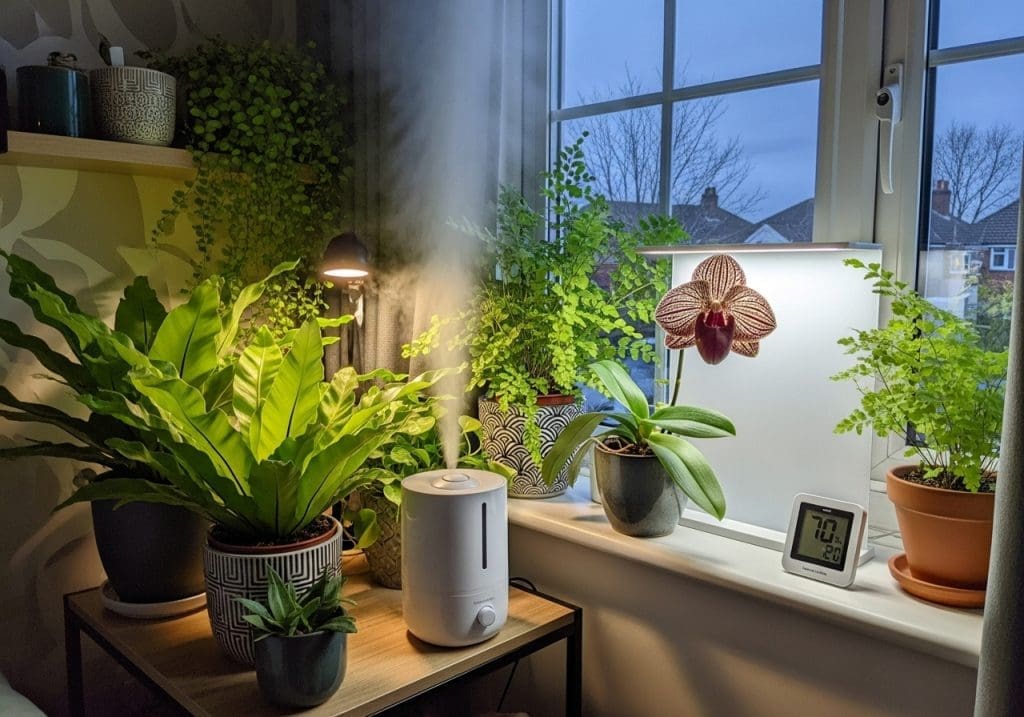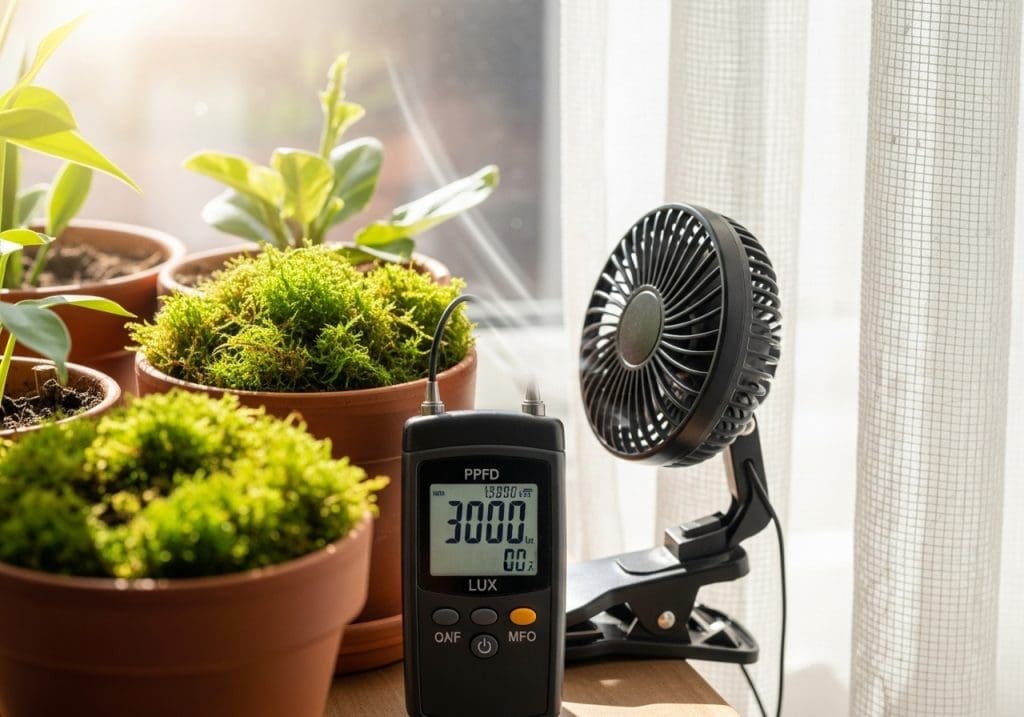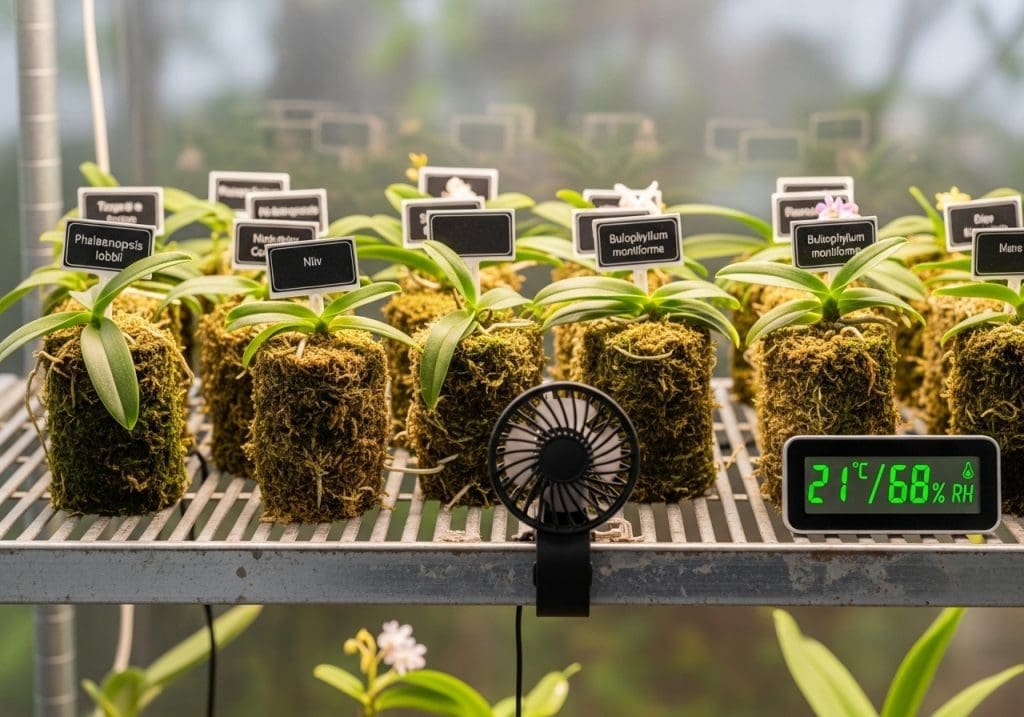If you’ve fallen for ferns, jewel orchids, hoyas, or mossy terrarium looks, you’ve likely been chasing a cloud-forest vibe without naming it. Think coolish temps, constant moisture in the air, and soft, diffused light—less jungle heat, more perpetual morning. Scientists describe tropical montane cloud forests as habitats characterized by frequent or persistent fog, which shapes everything about how plants drink, breathe, and grow.
“Sometimes I switch on the humidifier at dusk and the room feels like a tiny hillside—quiet, cool, and a little magical.” That’s the atmosphere cloud-forest plants are wired for, and yes, we can bring pieces of it home.

What makes a cloud forest… a cloud forest?
Cloud forests sit on mountain slopes within a narrow elevation belt where clouds hug the canopy. Leaves remain moist for long periods; epiphytes (plants growing on other plants for support, not for food) explode in diversity because air is wet enough for them to sip moisture through specialized tissues. Epiphytes are a keystone of cloud-forest biodiversity and nutrient cycles—one reason these habitats feel so alive. Cloud forests are defined by frequent and/or persistent fog, which shapes leaf wetness and water balance.
Kew highlights why these forests matter: they’re rich in endemic species and stabilize regional water cycles, yet they’re among the most threatened ecosystems globally. When we care for cloud-forest species at home, we’re caring for ambassadors of a fragile world.
Expert note: “Tropical montane cloud forests are characterized by frequent and/or persistent fog.” — R. S. Oliveira et al., plant ecophysiologist (2014).
The at-home translation: climate, light, and water
Let’s translate mountain mist to a living room shelf—without a greenhouse or a rainforest budget.
| Leaf-level target | Range | How to check |
|---|---|---|
| Temperature (day/night) | 18–24 °C / slightly cooler at night | Digital thermometer near plant shelf |
| Humidity (RH) | 60–70% steady for cloud-forest plants | Hygrometer placed at leaf height |
| Light (LUX at leaf) | 2,000–8,000 LUX, diffused | Phone lux app or meter at noon |
| Airflow | Gentle, continuous | Ribbon test: lazy flutter |
Safety note: For occupied rooms, aim to keep average indoor RH below ~60% (EPA) and under 65% (ASHRAE) to reduce mold risk; use steady airflow and short humidifier cycles to localize higher RH at the plant shelf.
Temperature: cool-to-mild, steady wins
Cloud-forest plants dislike sweltering rooms. Aim for 18–24 °C (64–75 °F) by day, slightly cooler at night. Keep them away from radiators/vents and from sun-baked glass.
Humidity: high but stable
The keyword isn’t “wet”—it’s moist air + gentle airflow. Many cloud-forest species thrive at 60–80% RH indoors. Rather than chasing spikes with hand-misting, focus on consistent humidity and circulation so leaves don’t sit soggy. For a quick primer on why steady humidity matters (and simple ways to raise it), the Royal Horticultural Society has an approachable guide. Aim for a steady 60–70% at leaf level with continuous gentle airflow; keep the room-average under ~60% for household safety and comfort (ventilate if you see condensation)
Pro tip: Put your hygrometer where leaves live, not on a far wall. You want the leaf-level reading.
Light: bright but softened
Imagine sunlight filtered through mist and canopy. Indoors, that’s bright indirect light—lux in the 2,000–8,000 range works for many ferns, jewel orchids, and hoyas. Sheer curtains or slightly higher LED height keeps light broad and gentle, avoiding crispy margins.
Need a numbers-based refresher? See your own guide: Bright Indirect Light for Ferns: A Practical Lux & Foot-Candle Guide.

Humidity at home: what actually works
There’s a lot of folklore here, so let’s keep it grounded.
- Humidifier near (not blasting) the plants is the most controllable method for stable 60–80% RH in a small zone.
- Airflow is non-negotiable. A quiet clip-on fan aimed to skim past the leaves prevents fungal spots and keeps boundary layers thin (that thin layer of still air hugging a leaf).
- Grouping plants creates a small, shared microclimate, raising RH a few points.
- Pebble trays help a little if the plant sits over—not in—water.
- Hand-misting feels nice but changes humidity for minutes, not hours; use it for gentle leaf rinses or for species that enjoy occasional surface wetting, not as your primary humidity tool.
| Device | Placement | Control idea | What you should see |
|---|---|---|---|
| Cool-mist humidifier | Plant height, 30–60 cm from leaves | Smart plug: short bursts (e.g., 10–20 min/hour) | Leaf-level RH ~60–70% without visible condensation |
| Clip-on fan | Aim past (not at) foliage | Low setting 24/7 | Ribbon “lazy flutter”, no leaf flop |
| Hygrometer | At leaf height (not back wall) | Weekly log | Stable trend; spikes settle within minutes |
Distance guidance mirrors the 30–60 cm setup in the 7-step section; keep airflow continuous to avoid leaf-surface wetness overnight.
If your seedlings or ferns still sulk, map your corner with a hygrometer and consider a larger humidifier or a mini greenhouse cabinet with vented airflow. (For gear sanity-checks, your post Quiet Humidifiers & Hygrometers for Bedroom Plant Lovers is on point.)
“On busy weeks I set a smart plug to cycle the humidifier in short bursts. It’s the only way I keep 70% without feeling like I live in a sauna.”
Watering: slow saturation, airy mixes
Cloud-forest roots are often shallow, creeping through moss and airy litter. At home:
- Use airy media that hold moisture yet drain fast (e.g., fine bark + perlite + sphagnum + high-quality potting soil for terrestrials; chunky bark + sphagnum for many epiphytes).
- Bottom-water or water slowly from the top until the pot is evenly moist; then let excess fully drain.
- Keep a consistent rhythm; avoid boom-and-bust cycles.

Airflow: the often-skipped ingredient
Cloud-forest leaves are frequently bathed in moving mist. Indoors, stagnant air plus high humidity equals trouble. Angle a quiet fan so leaves gently sway—you shouldn’t feel a draft on your face at plant level. Air exchange keeps stomata (leaf pores) happy and discourages botrytis and powdery mildew.
Quick airflow test: Hang a light ribbon near the plant shelf. You want a lazy flutter, not a flag-in-a-storm.
Light set-ups that mimic misted canopies
- Sheer-curtain windows (east or bright north) are perfect for many cloud-forest species.
- With LEDs, raise fixtures so light spreads wide; add a diffuser or step up the distance to soften intensity.
- Track lux at leaf height and adjust weekly. Leaves that pale or curl may be overlit in dry air.
If you’re balancing orchids, pair this with your post Best Light Conditions for Rare Tropical Orchids Indoors
A simple “cloud-forest corner” plan (7 steps)
- Choose the spot: bright-indirect window or LED shelf away from heaters/vents.
- Set humidity: place a cool-mist humidifier at plant height, 30–60 cm away.
- Add airflow: a quiet fan skimming past leaves, running low 24/7.
- Soil/mount: airy, moisture-holding media; for epiphytes, consider mounted pieces with sphagnum wraps.
- Water rhythm: slow soak, full drain; never let pots sit in water.
- Measure: keep a hygrometer at leaf level; track lux weekly.
- Quarantine newcomers: two weeks apart to avoid pest blow-ups.
If room RH creeps above ~60%, shorten humidifier cycles and increase ventilation.
Why quarantine? Cloud-forest ferns/orchids can be pest magnets when humidity rises. Your article on fungus gnat control gives a clean, measured plan if they show up.
Plant picks that love a mist-friendly setup
- Ferns: Blue star fern (Phlebodium aureum), maidenhair (Adiantum raddianum), rabbit’s foot (Davallia spp.).
- Aroids & friends: Jewel orchids (Macodes, Ludisia), small scindapsus, some anthuriums that prefer cool-bright conditions.
- Miniature orchids: Masdevallia, Lepanthes, Restrepia—cool to intermediate, moisture-loving, low-to-medium light.
Remember: Epiphyte = plant growing on another plant for support (not parasitic). Many of these prefer being mounted or potted very airy.
Frequently asked questions (from real plant corners)
Do I really need 80% humidity?
Usually not. Many species look great at 60–70% if light and airflow are right. Ask yourself: Am I chasing numbers or leaf health?
Is a bathroom a good substitute?
Sometimes, but fluctuating humidity and poor light work against you. A dedicated corner with a humidifier is more controllable. (RHS’ take on raising humidity at home backs this steady-state approach.)
Will a terrarium solve everything?
Terrariums deliver humidity but can overheat or stale out without fans/vents. Think vented cabinet or mesh-top terrarium with a small fan for the cloud-forest sweet spot.
How do I know if I’ve got the light right?
Measure lux and read leaves. If growth is leggy and pale, increase light; if edges crisp under high light and low RH, raise the light or diffuse it.
Q: Is it safe to run 80% RH indoors?
A: Keep the room-average under ~60% RH to reduce mold risk (ventilate if you see condensation). You can maintain a higher leaf-level micro-zone using short humidifier cycles plus constant airflow.
Why the conservation story belongs on your shelf
Caring for cloud-forest plants isn’t just aesthetic; it’s a living connection to threatened ecosystems. Kew underscores that these forests buffer water supplies and harbour unique species, yet they’re shrinking fast. Building a small cloud-forest corner teaches us to value consistency over extremes—a lesson pulled straight from the mountains.

Troubleshooting: when leaves sulk
- Brown tips despite high RH? Check EC/salts; flush pots and use softer water.
- Spots or fuzz in high humidity? Increase airflow and reduce leaf wetness overnight.
- Leggy growth? Raise overall light, but keep it diffused.
If orchids are your focus, pair this with Humidity & Temperature Needs for Healthy Tropical Orchids
“On the days I get it right—steady 70% RH, leaves gently moving, light like a calm morning—everything perks up. It’s the closest I’ve come to growing inside a cloud.”
Learn more (authoritative, gardener-friendly)
- Kew—Saving Cloud Forests: an accessible window into why these ecosystems matter and how they’re protected.
- RHS—Humidity for Houseplants: practical ways to raise humidity at home without the myths.
Change log: Aug 2025 — Added quick-targets table, gear placement table, and safety notes (EPA/ASHRAE); aligned distances with 7-step plan.

RarePlantCare Editorial Team produces expert content on rare plants.
Our articles are AI-assisted and human-edited before publication.
We aim to provide practical, evidence-based guides for plant lovers worldwide.
Learn more about our Editorial Policy


